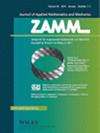探索振荡磁纳米流体在两个垂直交替导电表面内的热量和质量传递
IF 3.2
4区 工程技术
Q1 MATHEMATICS, APPLIED
Zamm-zeitschrift Fur Angewandte Mathematik Und Mechanik
Pub Date : 2023-07-08
DOI:10.1002/zamm.202300216
引用次数: 1
摘要
本文章由计算机程序翻译,如有差异,请以英文原文为准。
Exploration of heat and mass transport in oscillatory hydromagnetic nanofluid flow within two verticals alternatively conducting surfaces
The key attention of this paper is to explore the heat and mass transport in oscillatory hydromagnetic Titanium alloy water nanofluid flow within two vertical alternatively non‐conducting and conducting walls enclosing Darcy‐Brinkman porous medium. Motional induction is considered because it is sufficiently strong in comparison to Ohmic dissipation. Hall phenomenon is considered because the electromotive force induced due to revolving of fluid particle about the magnetic field lines is significant. Suitable physical laws (constitutive and field equations) are used to derive the equations leading the flow model. An analytical approach is followed to extract the solutions of the flow model. The quantities of physical interest such as wall shear stress (WSS), rate of heat transport rate (RHT) and rate of mass transport rate (RMT) at the walls are obtained from the extracted solutions. The physical insight into flow manners is discovered from the graphs and tables generated from the numerical computation of the solutions. It is important to note from the study that the volume concentration of nanofluid and magnetic diffusion produce resistivity in the flow and tends to slow down the fluid flow. Magnetic diffusion weakens the strength of the primarily motional induced magnetic field.
求助全文
通过发布文献求助,成功后即可免费获取论文全文。
去求助
来源期刊
CiteScore
3.30
自引率
8.70%
发文量
199
审稿时长
3.0 months
期刊介绍:
ZAMM is one of the oldest journals in the field of applied mathematics and mechanics and is read by scientists all over the world. The aim and scope of ZAMM is the publication of new results and review articles and information on applied mathematics (mainly numerical mathematics and various applications of analysis, in particular numerical aspects of differential and integral equations), on the entire field of theoretical and applied mechanics (solid mechanics, fluid mechanics, thermodynamics). ZAMM is also open to essential contributions on mathematics in industrial applications.

 求助内容:
求助内容: 应助结果提醒方式:
应助结果提醒方式:


